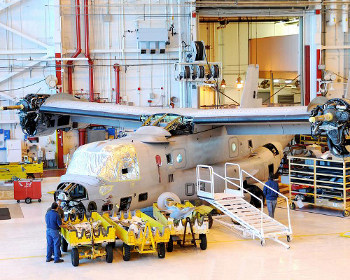 |
| January 15, 2013 | Volume 09 Issue 02 |
Designfax weekly eMagazine
Archives
Partners
Manufacturing Center
Product Spotlight
Modern Applications News
Metalworking Ideas For
Today's Job Shops
Tooling and Production
Strategies for large
metalworking plants
Saving magnesium components: Cold spray technology named DoD 2012 Project of the Year

Cold spray technology that adheres aluminum alloy particles to worn or damaged magnesium alloy components has been developed for aircraft repairs. [Image: U.S. Army]
A project involving the U.S. Army Research Laboratory's (ARL's) cold spray technology was named in November as one of six environment technology Projects of the Year for 2012, recognized for research and technology developments with significant benefits to the Department of Defense (DoD).
The Supersonic Particle Deposition for Repair of Magnesium Aircraft Components project, led by Victor K. Champagne, Jr., of ARL's Weapons and Materials Research Directorate (WMRD), was named the 2012 Environmental Security Technology Certification Program (ESTCP) Project of the Year.
ESTCP is DoD's environmental technology demonstration and validation program. The program's goal is to identify and demonstrate cost-effective technologies that address DoD's highest priority environmental requirements.
The project team developed a cold spray process that involves accelerating aluminum alloy particles to high velocities and impacting them on the surface of the magnesium alloy components. In their project, the cold spray process was demonstrated and validated to be a cost-effective, environmentally acceptable technology that could provide surface protection, as well as a method for restoring nonstructural parts of magnesium components that have been removed from service. The process can be incorporated into manufacturing, and portable systems can be developed for field repair. A cold spray demonstration facility was established at the Navy's Fleet Readiness Center - East, in North Carolina (formerly the Naval Air Depot Cherry Point).

During its more than six decades of operation, Fleet Readiness Center - East has provided maintenance, repair, and overhaul support to virtually every weapons platform the Marine Corps has flown -- from the inverted gull-winged F4U Corsair of World War II fame to the Corps newest V/STOL aircraft, the V-22 Osprey (pictured). [Image: U.S. Army]
This project resulted in the implementation of cold spray by Sikorsky Aircraft Company. Both Sikorsky and the Army Program Office for the UH-60 Blackhawk helicopter have approved cold spray for use as a repair technology for one UH-60 magnesium component, with other approvals expected soon.
ARL developed a Military Process Specification, "MIL-STD-3021, Materials Deposition, Cold Spray," that was selected for the Defense Standardization Program Award in 2008. With future implementation, the cold spray process should provide a significant return on investment through increased in-service life and the ability to reclaim extremely valuable components.
The Army, Navy, and Air Force have experienced significant corrosion problems with magnesium alloys that are used to fabricate many different types of aircraft components. The most severe of these problems is associated with large and expensive transmission and gearbox housings for rotorcraft that have to be removed prematurely because of corrosion, research indicates.
Many of the components cannot be reclaimed, because there is no existing technology that can restore them adequately for service.
The Corpus Christi Army Depot has millions of dollars of used magnesium housings waiting to be reclaimed. Overall, premature failures of these components cost the DoD approximately $100 million per year, Champagne said.
The winning team also included Robert Kestler of the Fleet Readiness Center - East; Robert Guillemette of Sikorsky Aircraft; Michael Kane of Army Aviation Missile Command; Timothy J. Eden of the Applied Research Laboratory at The Pennsylvania State University; Keith Legg of Rowan Technology Group; Darren Gerrard of Defense Science and Technology Organization, Australia; and Stacey Luker of Joint Strike Fighter Program's Environmental, Safety, and Occupational Health Team.
ESTCP and the Strategic Environmental Research and Development Program (SERDP) are the DoD's environmental research programs, harnessing the latest science and technology to improve DoD's environmental performance, reduce costs, and enhance and sustain mission capabilities. The Programs respond to environmental technology requirements that are common to all of the military services, complementing the services' research programs. SERDP and ESTCP promote partnerships and collaboration among academia, industry, the military services, and other federal agencies. They are independent programs managed from a joint office to coordinate the full spectrum of efforts, from basic and applied research to field demonstration and validation.
You can learn more about the cold spray process by reading an in-depth paper by Champagne here.
You can learn more about the cold spray powder materials by reading a paper by Champagne here
The full list of SERDP and ESTCP Project of the Year winners follows:
ESTCP Project of the Year
Supersonic Particle Deposition for Repair of Magnesium Aircraft Components
Victor K. Champagne, Jr., U.S. Army Research Laboratory
ESTCP Project of the Year
Modified Biopolymers as an Alternative to Petroleum-Based Polymers for Soil Modification
Steven Larson, U.S. Army Engineer Research and Development Center - Environmental Laboratory; J. Kent Newman, U.S. Army Engineer Research and Development Center - Geotechnical and Structures Laboratory; Gregory O'Connor, U.S. Army, PM-Joint Services; Gary Nijak, Jr., ETS Partners
Environmental Restoration, SERDP Project of the Year
Metric Identification and Protocol Development for Characterizing DNAPL Source Zone Architecture and Associated Plume Response
Linda M. Abriola, Eric L. Miller, Kurt D. Pennell, and C. Andrew Ramsburg, Tufts University
John A. Christ, U.S. Air Force Academy
Munitions Response, SERDP Project of the Year
Analysis of Next Generation Sensor Data
Dean Keiswetter and Jonathan Miller, SAIC
Resource Conservation and Climate Change, SERDP Project of the Year
SERDP's Defense Coastal/Estuarine Research Program (DCERP)
Patricia Cunningham, RTI International and the DCERP Project Team
Weapons Systems and Platforms, SERDP Project of the Year
Corrosion Protection Mechanisms of Rare-Earth Compounds Based on Cerium and Praseodymium
Bill Fahrenholtz and Matt O'Keefe, Missouri University of Science and Technology; Eric Morris, Deft, Inc.
Source: U.S. Army
Published January 2013
Rate this article
View our terms of use and privacy policy
